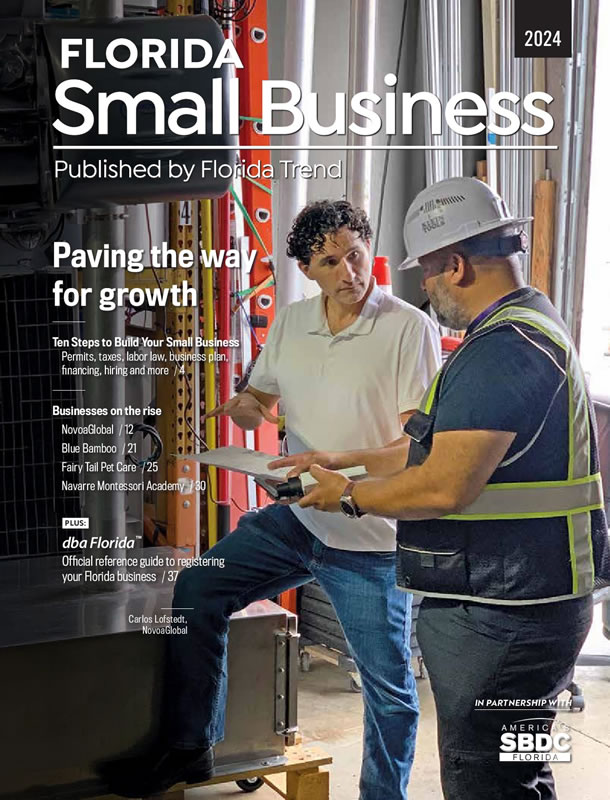Who dares to launch a business in the midst of a pandemic? A whole bunch of optimistic people, apparently. As coronavirus swept across the U.S. in 2020, new small business applications nationwide jumped by more than 24%, the highest-ever single-year increase on record.
We’re guessing that almost no one who submitted one of those new small business applications is planning to fail, but sadly, according to the U.S. Small Business Administration, many will — at the rate of 20% in their first year, 50% by their fifth. But here’s an interesting fact to consider: It likely will not be lack of money that takes a firm down, but rather the owner’s failure to plan ahead.
As you work through all the details of just getting your new business off the ground, you may be tempted to push aside thoughts about your future. Instead, as you work through the early stages of small business ownership, set aside some time to plan for your company’s future growth by answering these questions: Where do I see my business a year from now? In five years? In 10 years? What steps will I take to get there?
Commit your answers to paper and add notes to them periodically. Then, when you are seriously ready to expand, you’ll have a blueprint to follow. The sooner you begin asking — and answering — these questions, the greater the odds your business won’t be among the 50% that do not survive beyond five years.
Plan to expand … before you absolutely must
Don’t wait until you’re running out of room or resources to think about growing your business. As soon as the dust settles on your grand opening, begin laying the foundation for future expansion. Here are five steps to get you started:
- Revisit your business plan periodically. Look carefully at the plan you opened with. What new goals/ideas come to mind as a result? Which supporting documents need to be updated? Have you realized your expectations, and if not, why not? What steps will you take to get back on track?
- Fine tune your operations. Is your business operating at peak efficiency? Do you have the necessary tools/space to meet current and future needs? If the answer is no, what else do you need and how will you pay for it?
- Rate your team. Have you prepared written job descriptions for all positions and have the right people in place? How effective are your training programs? Do you have a strategy for attracting/hiring new personnel? Are you adding new job descriptions and revising existing ones as needed?
- Enlarge your market. Are you reaching all possible markets for your product or service? Is your marketing budget adequate and are your promotional strategies working? If not, what adjustments will you make?
- Assess your financial fitness. Have you reached your breakeven point? What’s your cash flow situation? Can you afford to expand? If not, what measures will you take now to make expansion financially possible on some future date.
Is this really the right time to grow?
In an ordinary business environment, your answer would likely be “Yes!” As long as your bottom line looks healthy, sales remain steady and you have cultivated a loyal clientele, now is the time to grow. But this is no ordinary business environment. COVID-19 arrived on our shores a year ago, and businesses of all configurations are still struggling with the aftermath. Should you even consider upsizing your business when most days it feels like you’re barely hanging on to the size you have?
That answer is also “Yes!” Growing your business in the midst of a crisis might actually be the key to ensuring that when the crisis is over, you have a business at all. These four steps will help you jump-start the process and stay on track:
- Continue to build customer relationships. Your business is already successful because you know and value your customers. So, when you can’t meet them face to face, use social media and email to keep in touch. Promote your website to help customers to find you online, and establish user-friendly protocols for ordering and delivery.
- Take care of your employees. Show that you value your employees in big and little ways. If they are working remotely, make sure to provide the resources and supplies they need to continue at their jobs. Be flexible and open to work schedules that allow for home-based family time and child-rearing duties.
- Practice smart marketing. Take advantage of technology to promote your products and/or services cost effectively. Consider hiring consultants with marketing experience in your industry to boost your company’s profile and increase customer interactions across social media platforms.
- Use technology to your advantage. While in-person events and face-to-face networking remain largely taboo, take advantage of opportunities for virtual events such as Zoom meetings, webinars and interactive discussions. Add give- aways and other incentives to draw participants.
Explore new avenues for expansion.
Growing your business doesn’t necessarily mean adding more space or hiring additional staff. It could mean that the time is right for expansion into an area of business you hadn’t previously considered, such as government contracting and/or exporting.
GOVERNMENT CONTRACTING
Government Contracting Every level of government must buy goods and services, and lucky for you, Florida currently ranks among the top 10 U.S. states for procurement of government contracts. There’s a ready market for government contracting and the rewards can be substantial, but is this a good choice for you? Quite possibly … but only if you know how to navigate the system, have the necessary infrastructure in place and understand how the procurement process works.
Landing a government contract on any level — federal, state, county, municipal — is not like pitching your product to a civilian buyer. A flashy brochure won’t cut it. Government agencies want to be assured that your business is capable of giving them what they need, when they need it and for the right price. To succeed in this highly competitive arena, you must understand exactly what you’re bidding on and then provide a corporate capability statement as evidence that your company can deliver it.
Government contracting can be tricky. So if this is your first time at it, don’t try to go it alone. Connect with an SBDC procurement specialist who can walk you through the process.
Listen Up, Veterans!
Contrary to popular belief, veteran-owned businesses do not receive preferential treatment with regard to government contracts; they must compete just like any other business and they land the job because they’ve done their homework, not because they have a military edge. As usual, a mere 3% of government contracts were set aside for veteran-owned businesses in FY 2019 compared to 26.5% for all small businesses. The bidding process itself is a level playing field with one exception: If a veteran-owned business goes up against a non-veteran-owned business for a VA contract and all things are otherwise equal, the vet will likely get the job.
Selling in the US
Landing a federal government contract takes time and effort. To position your firm for success, take these steps:
- Evaluate Understand what, when and how much government agencies buy. Is your product or service in demand?
- Plan Target government agencies and prime contractors that buy what you offer; develop a plan to reach them.
- Register Complete the required/mandatory government database registrations including: System for Award Management (SAM) and Dynamic Small Business Search.
- Prepare Develop a corporate capability statement; create government-focused collateral and e-marketing resources; secure preferred small business certifications such as: 8(a), Woman-Owned Small Business, HUBZone, Veteran-Owned and applicable state and local certifications.
- Pursue Be aggressive. Monitor computerized Bid Matching Services (daily searches and email alerts). Identify opportunities through government bid boards, posting databases and networking. Obtain a GSA Schedule contract, if applicable.
- Achieve Develop a government-accepted accounting system and be ready to handle possible contract audits, reports and modifications.
- Ask for Help Procurement specialists at the Florida SBDC Network stand ready to help small businesses pursue government contracting opportunities at all levels.
Selling in Florida
One avenue to expansion is as close as your computer. MyFlorida-MarketPlace, a division of the Florida Department of Management Services, has some 15,000 registered buyers who issue, on average, 5,000 purchase orders each month at three levels:
- Term Contracts
- Informal Purchases Less than $35,000. No requirement for competitive bidding.
- Formal Purchases Greater than $35,000; require competitive bidding.
- For details, visit dms.myflorida.com/business_operations/state_purchasing.
Exporting
Florida is home to nearly 60,000 exporters — second highest number in the U.S. — and nearly all of them are small- and medium-sized businesses with fewer than 500 employees. Florida exporters enjoy a multimodal system that ensures seamless movement of people and products between any two points on the planet as well as ready access to the nation’s second largest Foreign Trade Zone (FTZ) network.
Interested in expanding your business through trade? Here are some steps you can take:
- Evaluate your readiness. Seek export counseling assistance and/or participate in educational seminars, conferences and webinars.
- Create your export business plan and strategy. Apply for an Export Marketing Plan through the Florida SBDC Network, Enterprise Florida or U.S. Export Assistance Centers.
- Enter a new trade market and meet your buyers. Attend international trade shows and missions with Enterprise Florida and the U.S. Commercial Service.
- Learn about funding programs for exporters of goods and services. Contact the Florida Export Finance Corporation and EXIM Bank for information.
- Become familiar with trade rules and agreements. Seek assistance from Enterprise Florida and the U.S. Export Assistance Center.
Make it Happen
If you’re serious about becoming an exporter, don’t go it alone. Instead, partner with:
- U.S. Commercial Service Trade professionals in six Florida offices (see list on page 34) help companies get started in exporting or increase sales to new global markets by identifying and evaluating international partners, creating market entry strategies and navigating documentation challenges. For general information on regulations, licensing, free trade agreements and other topics related to exporting, visit export.gov.
- Florida SBDC Network In partnership with Enterprise Florida and the U.S. Commercial Service, Florida SBDC International Trade Specialists prepare Export Marketing Plans for qualifying Florida-based manufacturers and service providers. Approximately 100 hours is spent preparing each customized plan, which includes target market recommendations, overseas trade opportunities and an action plan for market entry. Each Export Marketing Plan costs $5,000 to prepare. However, qualifying companies are eligible for a $4,500 scholarship, bringing your company’s cost to $500.
Before you go global, ask yourself...
1. Is my business ready? Find out at trade.gov/exporter-assessments where three exporter assessments are available to help you determine your company’s readiness to: enter its first international market; expand into additional markets; or take on more challenging high-growth export markets.
2. Do I have a plan? Before jumping into uncharted waters, put your plans on paper. Assemble facts, identify constraints and set specific goals to ensure positive outcomes.
3. Have I done my homework? You wouldn’t take a foreign vacation without researching your destination, so why take your company overseas without prior knowledge? Study up on markets, trade barriers, regulations and other exporting details specific to wherever you’re headed.
4. Where do I even begin? If you know absolutely nothing about exporting, but would like to learn, a good place to start is the SBA Office of International Trade at www.sba.gov/offices/headquarters/oit.












